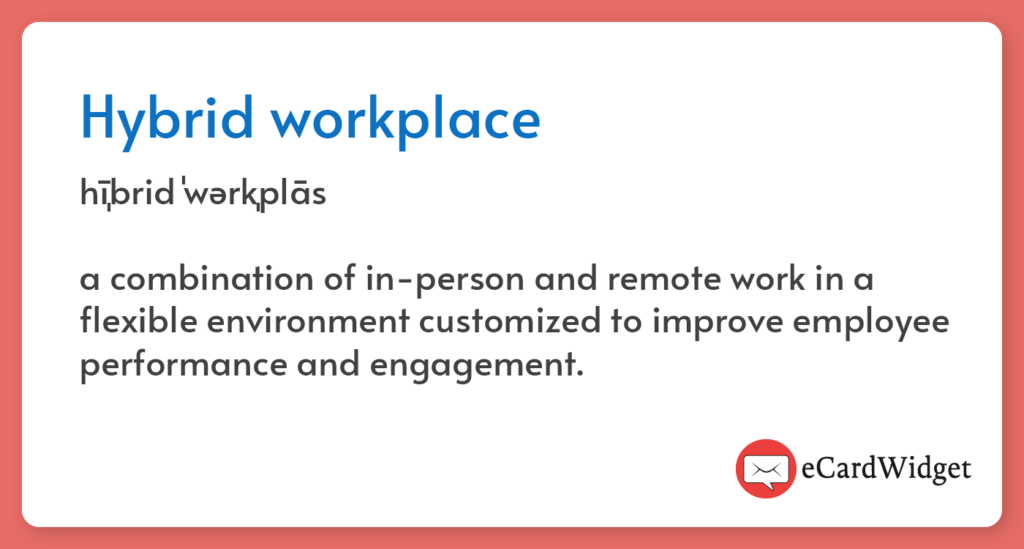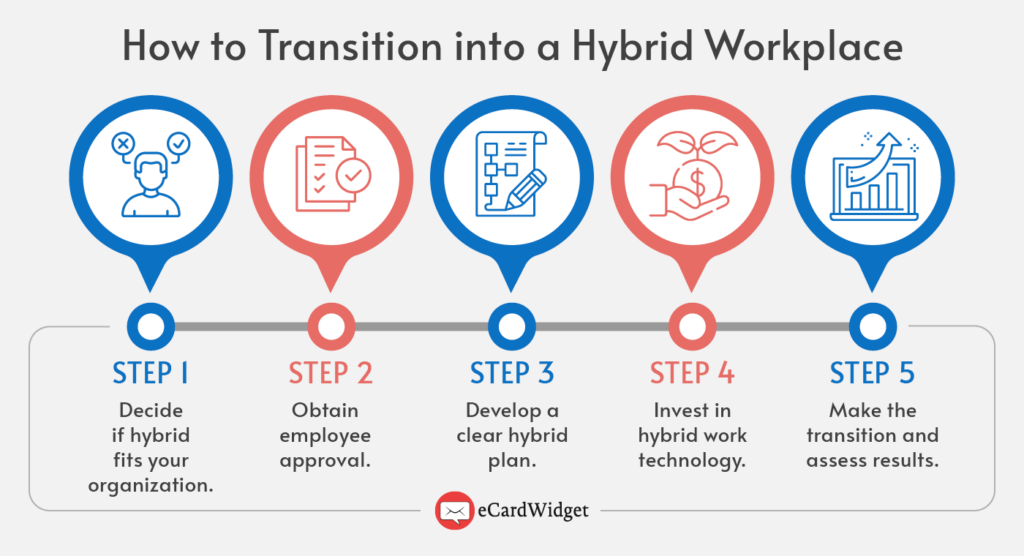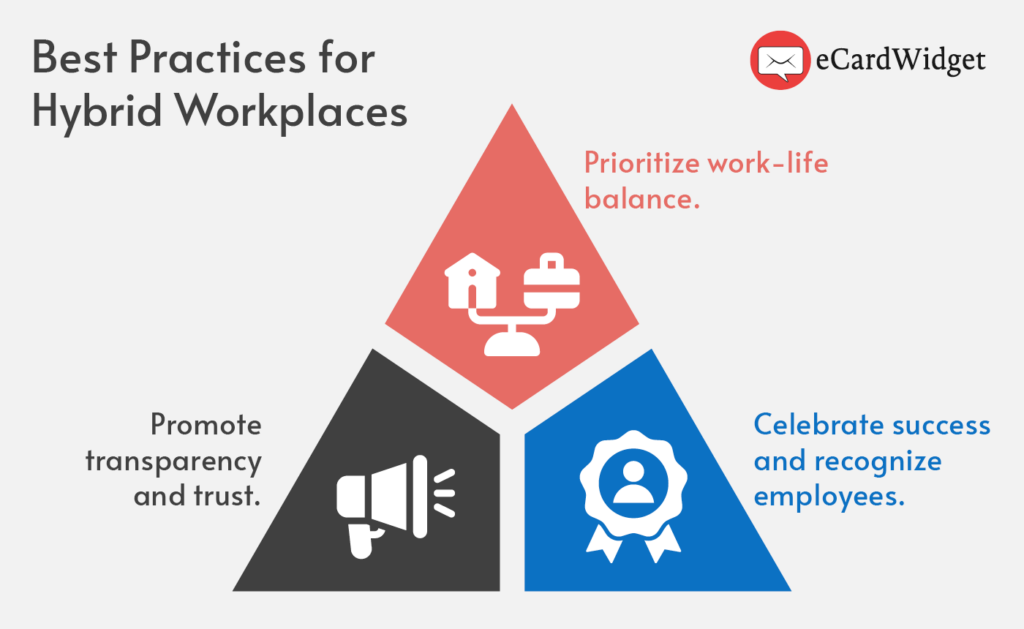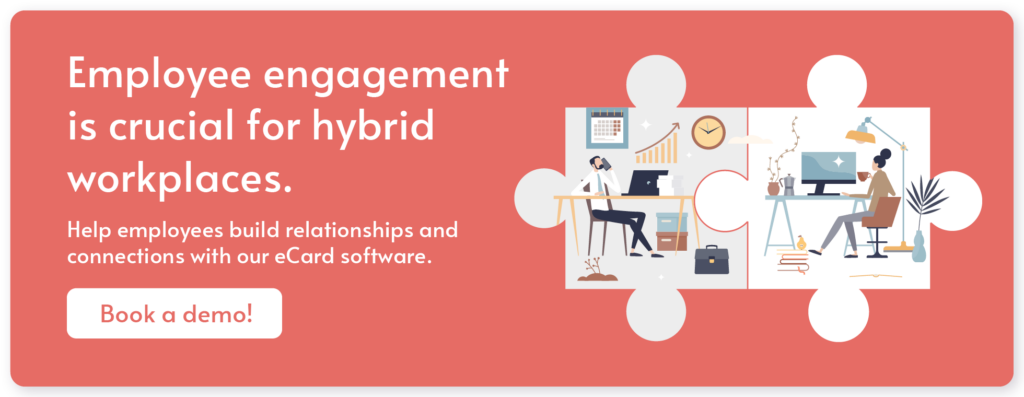According to workplace development analysts, hybrid work environments are on the fast track to becoming the norm. Experts at Gartner even state: “Hybrid is no longer just an employee perk, but an employee expectation.” After all, a hybrid workplace offers your employees both the flexibility of working from home and face-to-face interactions with clients and coworkers.
However, just like any major shift in the workplace, the transition from fully remote or in-person to hybrid can be challenging to navigate. To help you with that, this guide will cover the following:
- What is a Hybrid Workplace?
- Why is the Hybrid Workplace Growing in Popularity?
- What are the Benefits and Challenges of a Hybrid Workplace?
- How to Transition into a Hybrid Workplace: 5 Steps
- Hybrid Workplace Best Practices
With this information, you’ll be able to successfully pivot to a hybrid workplace, provide a better experience for employees, and keep them engaged with their work. Let’s dive in!

What is a Hybrid Workplace?

A hybrid workplace combines in-person and remote work in a flexible environment customized to improve employee performance and engagement. This format is best for businesses whose employees work predominantly in a digital space and don’t need to perform their tasks in a specific location.
The exact configuration of hybrid work varies from workplace to workplace, but usually, employees will work in the office on specific days or an as-needed basis. On the other days, they have the flexibility to choose where they work.
Why is the Hybrid Workplace Growing in Popularity?
It’s no secret that the COVID-19 pandemic caused a sharp increase in virtual workplaces. Studies have found that remote work accounted for 50% of paid work hours between April and December of 2020, a dramatic increase from the 5% of paid work hours pre-pandemic. However, since the pandemic, remote work hours have fallen, giving way to the hybrid workplace format. Why?
The first reason is technological advances. Due to the rise of conferencing technology, working from home has become more convenient than ever. It’s no longer difficult for businesses to implement a hybrid work system, and in fact, it may be more profitable to do so. Reports say that 63% of high-growth companies embrace the hybrid workplace, whereas 69% of companies with negative or no growth reject it.
The other reason for the hybrid workplace’s popularity is the shift in employee needs. 83% of workers prefer a hybrid workplace, citing reasons such as improved work-life balance, efficient use of time, less burnout, greater freedom, and higher productivity. And 29% of employees feel so strongly that they’d be extremely likely to look for other employment opportunities if their employer did not offer hybrid work.
What are the Benefits and Challenges of a Hybrid Workplace?
Like any other work format, the hybrid model has advantages and drawbacks that make it better suited for some organizations than others. Let’s take a closer look at the benefits and challenges of hybrid workplaces.

The Benefits of Hybrid Workplaces
The benefits of hybrid workplaces include:
- Improved employee experience. A hybrid work environment increases flexibility for employees by allowing them to work where it’s most convenient and they’re most comfortable. This improves employee happiness and satisfaction, helping you build a stronger and more positive work culture.
- Greater employee productivity. Happy employees are 12% more productive than their unhappy counterparts—in fact, actively disengaged workers cost the U.S. upwards of $550 billion in lost productivity per year. Plus, employees who are happy at work take 10 times fewer sick days. With a hybrid work format, you can increase employee satisfaction and productivity at the same time.
- Lower office expenses. As employees will be in-office only part of the time, you’ll have less overhead costs as you can rent smaller office spaces and reduce your power bill. Additionally, happier employees result in lower turnover rates, so you won’t incur the costs of hiring replacement employees as frequently.
- Reduced environmental impact. The hybrid work format reduces commute frequency for employees, lessening their environmental impact, especially if they travel by car. Additionally, with fewer people in the office, you can reduce your power and water usage, improving your company’s carbon footprint.
- Access to a larger talent pool. When it comes to hiring, you want to attract as many qualified candidates as possible. With 70% of employees preferring flexible working options, having a hybrid workplace will help your business set itself apart from competitors. Additionally, geographic constraints will be less of a concern with hybrid work, broadening your pool of potential employees.
Together, these advantages make the hybrid model an energizing work environment for your employees and a smart business decision for your organization.
The Challenges of Hybrid Workplaces
Although transitioning into a hybrid workplace comes with many benefits, it’s not without its drawbacks. A few challenges hybrid workplaces face include:
- Difficult employee communication. As employees are not physically in the same location as one another, they’ll have a more difficult time communicating with one another. You can mitigate this challenge by investing in messaging and conferencing tools such as Slack or Zoom.
- Lack of employee connection. Hybrid work formats reduce face-to-face time between coworkers, which can lead employees to feel disconnected and isolated from their peers. To ensure that employees feel engaged, develop virtual team-building activities that employees can attend to socialize and build relationships with one another.
- Unequal treatment between employees. There’s a chance that employees who choose to work in-office more frequently will be seen as higher achievers or better performers, regardless of their true abilities. If you transition to a hybrid environment, be sure to help managers align their expectations to fit your new workplace model.
- Less effective management. In a hybrid workplace, managers aren’t always able to see the work their employees are completing. This makes it more difficult for them to assess performance and give feedback. Set your managers up for success by implementing a check-in system or asking them to schedule regular one-on-one meetings with employees so that they stay up-to-date on their performance.
- Increased security risks. Since employees will all be working in separate locations on different networks, there’s a greater security risk for your organization. Have your HR and IT departments educate your employees on information security best practices to reduce the chances of a security breach.
Your organization should consider your current technology, office space, workflows, goals, and culture to see if you’re a good fit for the hybrid model.

How to Transition into a Hybrid Workplace: 5 Steps
Now that you understand the basics of hybrid workplaces, let’s take a look at the steps you need to take to transition into a hybrid workplace.

1. Decide if hybrid is a good fit for your organization.
Before you begin transitioning to a hybrid workplace format, establish if it is a good fit for your organization. Ask yourself the following questions:
- Do our organizational culture and responsibilities support flexibility?
- Can our core operations and services be delivered remotely?
- Can employees complete the majority of their duties off-site?
- Have employees expressed an interest in hybrid work?
- Can our office space be reconfigured to support hybrid work?
If you answer yes to these questions, then hybrid may be a good fit for your organization! You’ll also want to consider the costs associated with transitioning to a hybrid workplace, how hybrid work will impact your short- and long-term strategy, and how it will affect your reputation as an employer.
2. Obtain employee approval.
Since one of the main benefits of the hybrid work format is increased employee satisfaction, ensure that the change is one your employees would welcome. If any employees have previously expressed interest in hybrid work, reach out to them to get their current thoughts on a transition.
To get a broader understanding of your employees’ views on hybrid work, send a survey asking them about their opinions. Allow your employees to submit anonymous responses to ensure that they can give you feedback without fear of contradicting your plan. Compile the survey responses and assess them—if the majority of your employees want to transition to a hybrid workplace, then you have their stamp of approval to move forward with your plans.
3. Develop a clear hybrid plan.
Now that you know a hybrid workplace is a good strategic move for your organization and you’ve acquired employee buy-in, develop a plan for the transition. This plan should include:
- Logistics of the transition. This includes your budget, the technology you’ll need to purchase, how you’ll reconfigure your office space to accommodate hybrid work, what kind of training your employees will need, legal or HR considerations, and any security concerns. Outline any tasks you need to complete to ensure a smooth transition.
- Policies for hybrid work. If there are any rules for your hybrid work policy, you should include them in your plan. This may include eligibility criteria, mandatory in-office days, necessary equipment, and more. For example, you could specify that employees are only eligible for hybrid work if they’ve been at the organization for more than 90 days and are not on a performance improvement plan.
- Expectations for hybrid work. Inform your employees about your expectations for hybrid work, including work hours, meeting deadlines, attendance, email response times, and more. For example, you may stipulate that if an in-person meeting is scheduled for a day that your employee decides to work from home, they must attend the meeting via conference software.
If you’re feeling trepidation about converting to an all-hybrid format, you can take smaller steps to see if the format would work first. For example, you could choose a single team to go hybrid for a 30-day trial period. At the end of that period, re-assess your hybrid workplace plan, make any necessary changes, and then roll it out to the rest of your employees.
4. Invest in hybrid work technology.
To successfully transition to hybrid work, upgrade your tech stack to enable your employees to work together virtually. Software solutions you need for a hybrid workplace include:
- Communication tools. As prompt communication is generally a pain point for hybrid workplaces, set your employees up for success by providing them with the tools they need to reach each other quickly.
- Conferencing software. With video conferencing software, no matter if your employees are in-office or at home, they’ll be able to attend important meetings. Plus, having a video option helps them connect and form relationships with each other, even if they don’t spend time together in the office.
- Project management platform. To organize workflow, a project management platform is essential for hybrid workplaces. These tools provide a virtual space where you can assign tasks and manage ongoing projects, and your employees can record their progress with their work.
- Document collaboration tool. A document collaboration tool reduces data siloing, allowing employees to access each other’s materials and work together on a single document. For example, Google Workspace offers tools that facilitate collaboration on text documents, powerpoints, spreadsheets, and more.
There are plenty of other types of software you can purchase and use to streamline your organization’s hybrid workflow, such as employee engagement tools, depending on your needs. What we’ve listed above is merely the minimum needed to ensure hybrid success. Feel free to get in touch with other members of your leadership team to discuss if you want or need any additional tools.

5. Make the transition and assess results.
At this point, you’re ready to make the transition into a hybrid workplace. As we’ve mentioned previously, you can start with a single team and then slowly extend the hybrid format to all your employees. As you roll out these changes, continually monitor their effectiveness so you can make targeted improvements. You can assess your hybrid approach’s success by:
- Surveying your employees. Your employees have an in-depth understanding of your internal practices. Send them a survey periodically throughout your hybrid rollout to see what you can improve on and what you should maintain.
- Tracking key performance indicators (KPIs). Your KPIs include metrics such as the amount of work completed, quality of work, employee retention rate, and employee satisfaction. Track these metrics while you introduce the hybrid model to gauge its impact on your workplace.
- Ask external parties. Sometimes, it can be difficult to detect flaws in your organization from the inside. Ask important stakeholders, such as your clients, partners, or board of directors, to provide feedback about your organization after the switch to the hybrid model.
Ensure that your leadership team collects this data frequently, especially at the beginning of the hybrid rollout. The adjustment from an in-person or remote-only work format to a hybrid one can be challenging, so stay updated with any obstacles and continuously develop strategies to improve the hybrid workplace experience for you and your team.
Hybrid Workplace Best Practices
Your organization’s leaders may need to make adjustments to company culture to ensure employee satisfaction and productivity in a hybrid environment. Start with these best practices:

1. Prioritize work-life balance.
One of the most difficult challenges of remote work is the separation (or lack thereof) of boundaries between work and personal life. However, a healthy work-life balance is a key contributor to employee satisfaction, productivity, and retention.
Help employees working at home maintain a work-life balance by ensuring your leadership team understands that your employees’ jobs shouldn’t consume their lives. Boost your employees’ quality of life by providing them with resources to create a dedicated workspace at home, such as a take-home desk and monitor. This allows them to better separate their work and home lives and avoid burnout.
Additionally, your leadership team can open the floor to employees to create after-work social clubs and hobby groups. Some popular options include:
- Book clubs
- Knitting circles
- Movie watch parties
- Foodie groups
This allows your employees to get to know each other in a casual atmosphere and stimulate conversation about their interests, building a positive work culture even through remote work.
2. Promote transparency and trust.
Two-way trust between leadership and employees is crucial to make the hybrid model function. Managers should trust that their subordinates are getting their work done, whether they’re remote or in person, whereas employees should trust that managers are providing them with the resources and intel they need to succeed.
Ideally, everyone should feel comfortable enough to take ownership of their workload, produce a high-quality product, and have the autonomy to govern themselves when away from the office. The leadership team shouldn’t pry too much into their employees’ work unless issues arise that must be addressed. Instead, instruct leadership to make themselves available for their employees to approach them when necessary, giving them the agency to problem-solve on their own.
Use a calendar-sharing tool that allows employees to view their team members’ availability and arrange meetings if necessary. Or, encourage managers to host “office hours” once a week for their team members.
3. Celebrate success and recognize employees.
To facilitate a positive work environment, celebrate successes and implement employee recognition strategies. Regularly recognizing employee achievements, both on- and offline, helps increase your employees’ confidence and commitment to their work. This is especially important in a hybrid environment where employees are more likely to feel disconnected from their work while away from the office and their team.
Bake positive reinforcement into your organization’s culture by regularly recognizing employee achievements. It isn’t just important for leadership to recognize employees—peer-to-peer recognition can help strengthen relationships between employees in different workplace environments.
Don’t be afraid to invest in employee recognition tools to facilitate a positive hybrid workplace culture. If you’re looking for employee recognition software, consider eCardWidget. Through our cost-effective and customizable solution, employees can send unique shout-outs to one another via email. For a rundown of how it works, take a look at this video:
With eCardWidget, a positive hybrid workplace culture is easier than ever.
Wrapping Up: The Hybrid Workplace is Here to Stay
While hybrid work is the new normal for many industries, it can be a difficult transition that requires lots of in-depth planning and fine-tuning.
As you start shifting to a hybrid workplace, ensure that your employees’ well-being and job satisfaction are at the core of every decision. Take their feedback into account and offer compromises when possible. Remember, building a functional hybrid workplace requires effort from all sides, fueled by discourse and a shared pursuit of your organization’s goals and values.
With the right priorities and tools, you can improve your workplace in the long term and provide your employees with a superior work experience.
To learn more about hybrid workplaces, explore these additional resources:
- The Ultimate Guide to Succeeding in a Hybrid Work Culture. If you’ve decided that the hybrid workplace is for you, this guide will teach you the best practices for creating an enriching hybrid work culture.
- Peer-to-Peer Recognition: Fostering a Strong Work Culture. Peer-to-peer recognition can make your workplace feel like a community. Elevate your peer-to-peer recognition offerings with these top tips.
- A Complete Guide to Employee Engagement + Top Ideas. Employee engagement is crucial for hybrid workplaces, which can’t rely on face-to-face interactions. Master the basics in this guide and learn top engagement ideas for all types of workplaces.



